How many types of Betta fish are there?
To be honest, trying to figure this out can be kind of confusing. Not everyone agrees on what constitutes a Betta “type”.
Some break it down by tail type, others by tail type plus color, and still others by tail type, color and pattern, giving specific names for certain combinations.
So, depending on your perspective, there could be countless.
To help you understand the different types of betta fish, I’ve broken this guide down into three sections, covering: different tale types, color varieties, and patterns.
Table of Contents
Betta Fish Tail Types
1. Veil Tail

- Tail/Fins: Long flowing fins with a tail that swoops up then trails down, even when the fish flares. Large dorsal and anal fins
- Color: available in almost every color
- Common Patterns: Solid, butterfly, dragon scale, piebald, full mask, grizzle, bi-color; marble and koi very rare
- Behavior: less aggressive
Veil tail is the most common variety of Betta available in the aquarium trade. They have a long tail that swoops up and then curves back down as it trails behind the body.
Since they are bred by the millions, you can find them in almost every pattern and color combination possible. Marble and koi patterns might be hard to find, but do sometimes pop up.
Veil tails are not strong swimmers and do best with only a gentle current in their tank.
They are not as aggressive as short-finned varieties.
2. Crowntail

- Tail/Fins: reduced webbing between rays of the fins creates long spikes on dorsal, anal and caudal fins
- Color: every color
- Common Patterns: Solid, butterfly, dragon scale, piebald, full mask, grizzle, bi-color; marble and koi very rare
- Behavior: can be much more aggressive than veil tails
A male crown tail Betta is a spectacular sight. Its dorsal, caudal (tail) and anal fins all have reduced webbing in between the rays so the last ½ to ⅓ of the fins is made up of beautifully flowing spikes. The rays dance and flutter together as the fish swims, especially if it is trying to put on some speed.
Crowntails are stronger swimmers than veil tails, but do still benefit from subdued current in their tanks.
This variety can also be much more aggressive than veil tails, but it depends on the individual fish and its ancestry.
Pro Tip: Whether or not a Betta is aggressive depends on its genetics.
Basically, if the fish’s parents were docile and laid back, it will be too. But if it comes from a family of scrappers, chances are it will be aggressive.
Crowntails can be a little more delicate when it comes to disease and injury, so it’s important to keep them in pristine water conditions.
They are the next most common Betta, so you can find them in almost every color and pattern. I most often see them in grizzle and bi-color.
3. Halfmoon

- Tail/Fins: 180° tail with overlapping dorsal and anal fins
- Color: available in all colors
- Common Patterns: Solid, butterfly, dragon scale, piebald, full mask, grizzle, bi-color; most butterly pattern Bettas are halfmoon; marble and koi very rare
- Behavior: more aggressive than veil tails
A halfmoon Betta has an enormous rounded tail that spreads 180°. The trailing edge of the tail is round, so the silhouette of the tail looks like a semicircle (or half moon!).
The dorsal fin is also quite large and tends to have a rounded shape, not swooped like a veil tail. The anal fin forms a large curtain under the fish’s belly. All three fins overlap each other, making the fish look like a blooming flower (well…to me anyway).
This variety is also widely available in pet stores, but it’s not quite as common as the veil tail and crowntail.
It can be more aggressive than veil tails, but this depends on the individual fish.
Most butterfly Bettas have the halfmoon tail type. This makes the pattern look even more beautiful since the anal, dorsal and caudal fins all overlap each other like flower petals.
4. Dumbo/Elephant Ear

- Tail/Fins: very large, ruffled pectoral fins that resemble an elephant’s ears, can be found with any tail type but they’re most often halfmoons
- Color: available in all colors
- Common Patterns: Solid, butterfly, dragon scale, piebald, full mask, grizzle, bi-color; marble and koi very rare
- Behavior: more aggressive than veil tails
Dumbo Bettas (sometimes called elephant ear or EE Bettas) have enlarged pectoral fins that can be as much as 5 times bigger than normal and have giant ruffled edges.
Bettas normally do a lot of their swimming with their pectoral fins. So they’re constantly fluttering these ruffled fins. It looks almost like a dancer with a big feathered fan.
These fish can be hard to get a hold of in regular retail stores since they’re hard to breed.
Make sure to give them a gentle current since their heavy pectoral fins can make swimming a little more difficult.
5. Rosetail

- Tail/Fins: halfmoon Betta whose tail has extra rays and ruffled edges
- Color: available in all colors
- Common Patterns: Solid, butterfly, dragon scale, piebald, full mask, grizzle, bi-color; marble and koi very rare
- Behavior: more aggressive than veil tails
Rosetails were bred from halfmoon Bettas. Their caudal fins have extra rays and branching, making them ruffled. Just like a halfmoon, their tails can spread to 180°, but all the extra rays mean that the tail folds back and forth in on itself.
They really do look like flowers or a frilly dress.
All that extra fin does weigh the fish down, though, and can impede their swimming.
And it’s easy to snag all that extra fin on things in the tank. So make absolutely sure there are no sharp or rough edges to damage that gorgeous tail.
Some argue that the price for these beautiful tails is too high. Rosetails can become lethargic because trying to drag around that big tail is so hard. They would rather hang out in a hiding spot than swim around.
Also, sometimes rosetails break the rays of their tails. This puts them at higher risk for infection.
They can also develop a behavior called tail biting. The fish literally starts biting its own tail off. There is a lot of heated debate about what causes tail biting, but no matter the cause, it is known for certain that it’s all too common among rose and feather tail Bettas.
Tail biting also makes rosetails more prone to infections that could be life threatening.
They also may have a shorter lifespan than other varieties. This could be due to poor breeding practices that focus more on getting a certain tail shape versus breeding robust fish.
They may be fairly aggressive since they were bred from halfmoon Bettas.
6. Over Halfmoon/Super Delta Tail
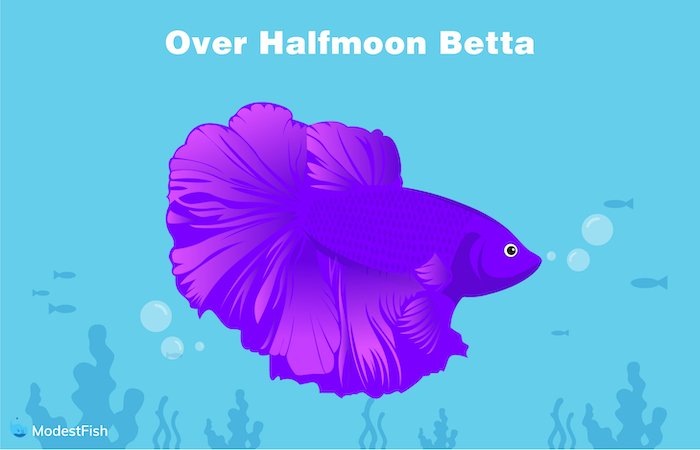
- Tail/Fins: tail and fins like a halfmoon but the caudal fin can spread more than 180°
- Color: available in all colors
- Common Patterns: Solid, butterfly, dragon scale, piebald, full mask, grizzle, bi-color; marble and koi very rare
- Behavior: more aggressive than veil tails
An over halfmoon Betta has the same tail shape as a regular halfmoon, but the tail can spread more than 180°.
Their anal and caudal fins are similar to that of a regular halfmoon, the distinction is all about that huge tail.
7. Feather Tail

- Tail/Fins: extremely ruffly anal, dorsal and caudal fins
- Color: available in all colors
- Common Patterns: Solid, butterfly, dragon scale, piebald, full mask, grizzle, bi-color; marble and koi very rare
- Behavior: more aggressive than veil tails
A feather tail is like a rosetail gone completely berserk. They look like a cross between a rosetail and a crowntail. They have the extra rays and branching like a rosetail but they also have fingers of rays and webbing that make the edge of their fins look like, well, feathers.
They really are beautiful. Their fins flutter around as they move and you can’t help but be a bit mesmerized.
But, just like rosetails, feather tails can be prone to problems like ragged fins, broken rays, tail biting and shortened lifespans.
8. Plakat

- Tail/Fins: shorter, less ornate fins/tail
- Color: all colors available
- Patterns: all patterns available, this variety has marble and koi
- Behavior: EXTREMELY aggressive, they are also notorious for trying to jump out of the aquarium
Plakat Bettas (pronounced pla-COT) are much more similar to the wild form of the Betta splendens. These fish were bred in South East Asia specifically for fighting. So they have much shorter fins and large, strong bodies.
Their bodies are longer than long-finned varieties and their dorsal fins are usually round and about a third of the size of a veil tail. Plakat tails are fan shaped and about half the size of a veil tail or halfmoon. And their anal fins only extend an inch or so from their bellies.
But don’t worry, this is still a knockout little fish that can be found in a huge variety of vibrant colors.
They are much faster than long finned varieties and much stronger swimmers.
Plakats are also the most aggressive variety of Betta. Only the most aggressive fighting fish were selected for breeding, so these are some rage filled little fish.
They also have a bad habit of jumping out of their tanks. You absolutely need a tank with a tight lid that doesn’t have any gaps. I’ve seen stories warning that a plakat jumped out through a small hole meant for a filter or air hose to come through.
Plakats will be happier in a larger tank where they can have more room and be really active.
If you’re interested in the marble and koi patterns, these are the fish for you. Most of the marble koi that have been bred are plakat varieties.
9. Halfmoon Plakat

- Tail/Fins: slightly larger than regular plakat with halfmoon shaped tail
- Color: all colors available
- Common Patterns: Solid, butterfly, dragon scale, piebald, full mask, grizzle, bi-color; marble and koi very rare
- Behavior: very aggressive and prone to jumping
A halfmoon plaket has almost all of the same characteristics of the normal plakat, but has been bred to have a somewhat bigger tail. Just like a halfmoon, the tail spreads to 180º and is shaped like a capital “D”.
They are still an active and aggressive fish with the same feisty personality you’d expect from a plakat.
Halfmoon plakats are also notorious for jumping out of their tanks. So it’s best to have a tight fitting lid if you plan to keep one of these beauties.
10. Double Tail

- Tail/Fins: two distinct caudal fins that are separated at the base
- Color: all colors available
- Common Patterns: Solid, butterfly, dragon scale, piebald, full mask, grizzle, bi-color; marble and koi very rare
- Behavior: aggression depends on the fish’s ancestry
Double tails are very unique looking because they have two distinct tails. Each caudal fin has a distinct base, one above and one below the midline of the fish.
The double tails are the result of a genetic mutation that is present in all Bettas. Because of that, double tails can be found with any tail shape.
11. Delta Tail

- Tail/Fins: cross between veil tail and halfmoon, caudal fin flares out to a triangle
- Color: all colors available
- Common Patterns: Solid, butterfly, dragon scale, piebald, full mask, grizzle, bi-color; marble and koi very rare
- Behavior: aggression depends on individual fish
The delta Betta has a tail that is roughly triangular in shape, narrow near the body and then flares out with a rounded edge.
This varieties’ name comes from the silhouette of its tail, which resembles the Greek letter, delta (Δ).
Most likely created by crossing veiltail and halfmoon Bettas.
12. Half Sun
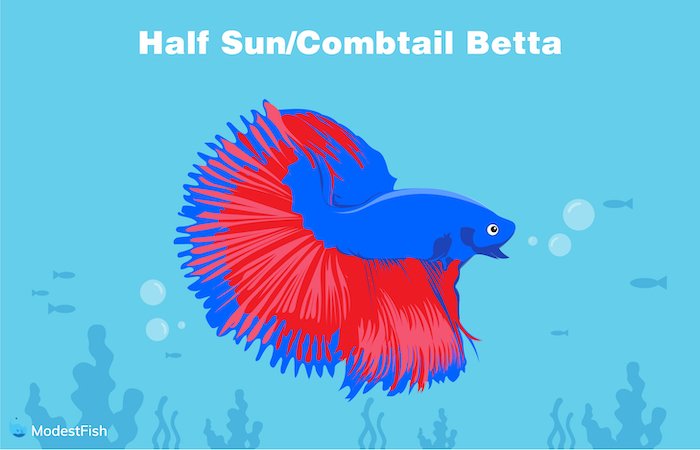
- Tail/Fins: halfmoon fins but tail has fringe of spikes
- Color: all colors available
- Common Patterns: Solid, butterfly, dragon scale, piebald, full mask, grizzle, bi-color; marble and koi very rare
- Behavior: more aggressive than a veil tail
The half sun Betta is probably my favorite. Bred from halfmoon and crowntails, they have a halfmoon shaped tail, but a fringe of rays extend a little past the webbing, making the tail look like a stylized sun.
I like the half sun because it’s stunning and unique, but the tail isn’t overly extreme like feather or rosetail.
They have a spunky halfmoon-like personality.
13. Spade Tail

- Tail/Fins: anal/dorsal fins of a veil tail, tail that flares out then curves to a point
- Color: all colors available
- Common Patterns: Solid, butterfly, dragon scale, piebald, full mask, grizzle, bi-color; marble and koi very rare
- Behavior: similar to a veil tail
The spadetail Betta’s fins look just like a veil tail, but the tail curves back down to a point, just like a spade from a playing card.
This tail type is actually quite rare. It used to be quite common in the 90s but is much more difficult to obtain these days.
Betta Fish Color Types
Despite being one of the most colorful freshwater fish, you may be surprised to learn wild bettas are dull colored. Only exhibiting bold colors when agitated. However, due to centuries of selective breeding captive bettas are now available in a vast array of different colors and pattern types.
Some bettas can even change color during their lifetime.
This sheer variety of color and pattern combinations is due to their layers of pigmentation in their skin. At any layer of pigmentation, a betta fish can have any combination of red, black, green, yellow, iridescent, or blue.
Blues, turquoises, and greens are iridescent and can appear to change color as lighting changes. Betta fish have this ability because these select colors are created through refraction within a layer of guanine crystals.
Popular colors of betta fish include:
- Red
- Blue
- Yellow
- Black
- White
- Orange
- Alien
- Gold
- Green
- Candy
- Nemo
- Cellophane
- Metallic
- Purple
- Copper
- Mustard Gas
Different Betta Fish Pattern Types
Here are examples of betta fish pattern types available:
Solid
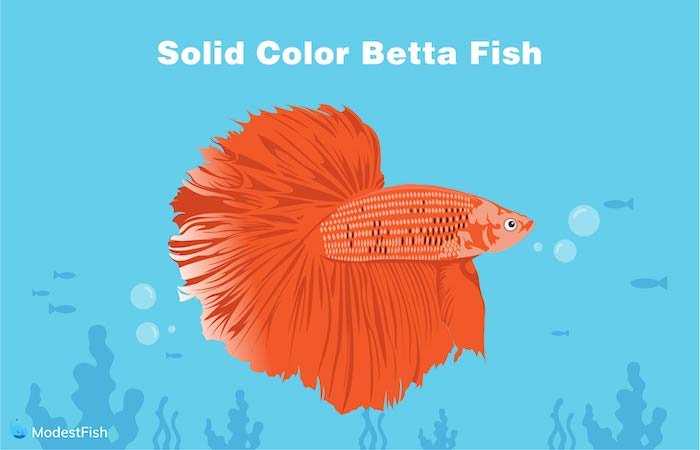
Just like it sounds, one solid color.
Marble
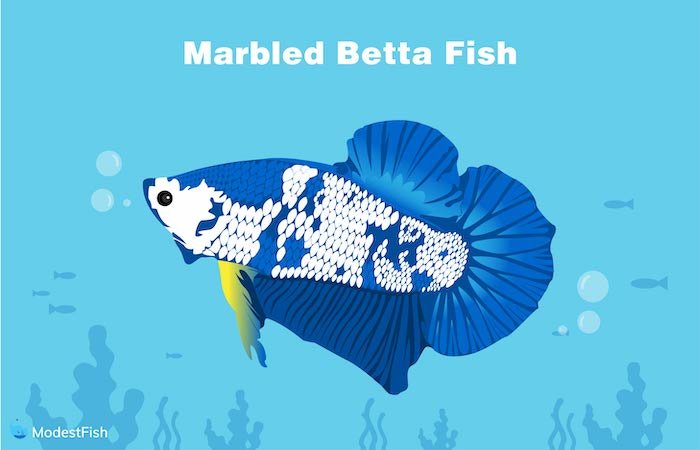
Splotches of white on the body/fins. This pattern can develop throughout a betta’s lifetime, a process known as marbling. This is due to a transposon, when a DNA sequence changes its position in the genome, altering a cell.. (Also common in Koi Bettas).
Dalmatian

White with black or red speckles.
Butterfly
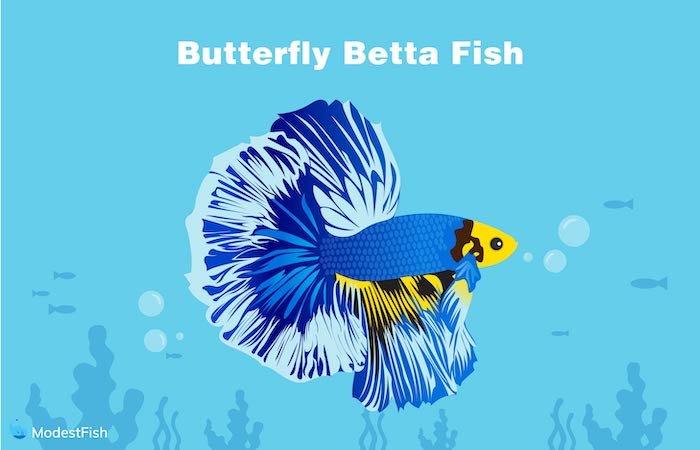
Two or three colors on the body cuts off and last third of tail/fins will be white or transparent.
Dragon Scale

Body scales are outlined in black with metallic sheen over most of the body.
Full Mask
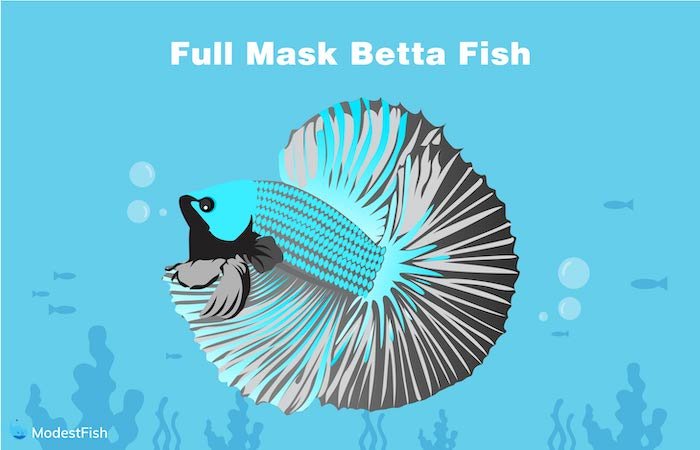
Black markings around the mouth (resembles a mask), with a colorful body.
Koi

Marble patterns with several colors, like orange, red, white and black
Bi-Color

Two different colors, one on the body, the other on the fins/tail
Grizzle

Two or more colors that bleed together, it looks like the colors are blended at the edges with a paintbrush
Rarest Types of Betta Fish
The rarest type of Betta is the fantail variety. This fish has two caudal fins that are side by side but fused at a small point at the top, making it look similar to a fantail goldfish.
This variety is so rare that you can’t really find any information on them or anywhere to buy them.
The fantail Betta might as well be a unicorn!
The only thing I’ve been able to find on them is a short reference to them on YouTube that claims these Bettas could be sold at auction for an expected $5,000 each!
Beyond that, the spade tail is also very difficult to find unless you contact a private breeder. I was able to find some listings for spade tails Bettas, but all of them were listed as “sold out.”
Since they’re so rare, expect them to carry a hefty price tag.

Thank you for the very interesting read on Bettas.
I am 53 and have been collecting both fresh and saltwater fish, off and on, since I was 13 years old.
It’s refreshing to see young folks with the love of aquatic life such as you.
I would enjoy reading more of your writings.
Thank you Katherine (with a “K” 😜)
Very informative
Thank you for sharing your knowledge. I’ve learned a lot. My husband and I are just new betta keepers here in Cavite, Philippines.
Very informative description. I learnt more. thank you very much.
I have a feathertail very unique, yes it’s like a rosetail gone beserk
Hi! This article was extremely informative and thorough. Thank you for the illustrations and descriptions. I am a new betta owner and want the absolute best for my fish. I’ve introduced catalpa leaves to the tank prior to adding my fish. Thanks again!
Thank you, Nicole. I’m glad you found it useful. Adding catappa leaves is an excellent addition! Adding some floating plants to your tank will also help your new betta settle in. Just remember, it can take a few weeks for them to settle properly and be relaxed. Wish you all the best.